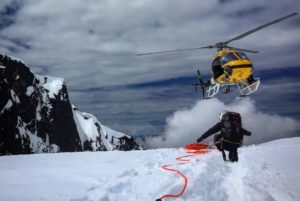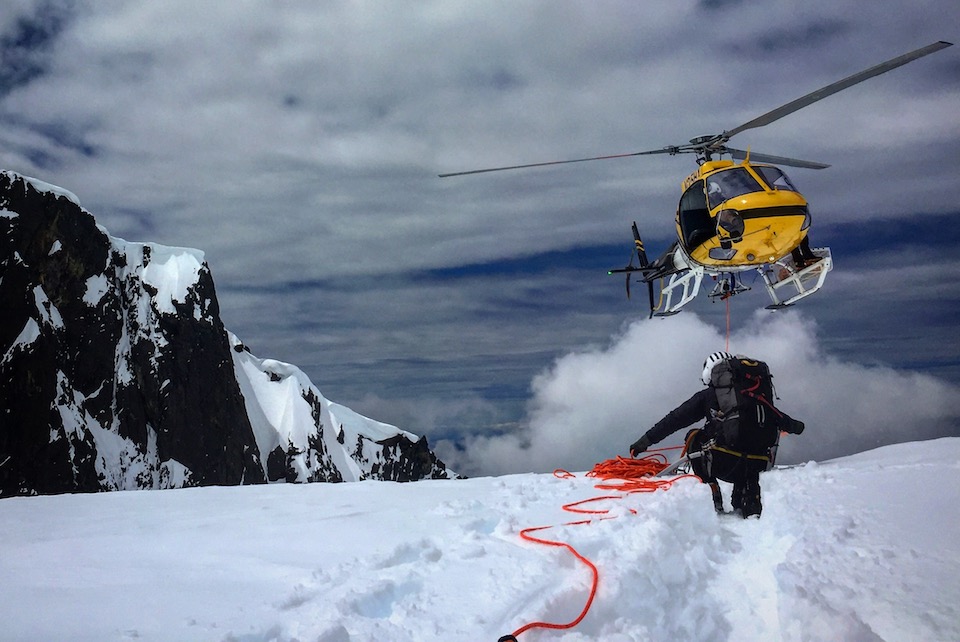On Sunday, June 24, 2018, a pilot, National Park Service (NPS) helitack crew, and climbing rangers on board the Mount Rainier National Park-based rescue helicopter successfully completed a rescue in each of the three large national parks in Washington State in a single day.

At 9 a.m., a call came into the North Cascades National Park Communication Center reporting a backpacker with respiratory distress in the northwest section of the park wilderness. By midday the clouds had lifted, creating the necessary visibility to include the helicopter in the rescue operation. Working with the North Cascades National Park climbing rangers the crew performed a short-haul rescue of the 18 year-old ill patient, evacuating him to Marblemount from where he was transported to the hospital.
(Short-haul is a rescue technique in which a rescuer and patient are suspended on a line below the helicopter, typically employed in situations where rugged terrain makes it impossible for a helicopter to land.)
The pilot and crew then responded to Olympic National Park to perform a medical evacuation in the late afternoon of a visitor who had gotten lost after going out for a day hike on Tuesday. On Saturday afternoon park dispatch received a call from a hiker who had encountered the 55-year-old man and reported he was in need of medical attention. Olympic National Park rangers contacted the lost hiker at 2:30 a.m. on Sunday morning after six days in the backcountry. The man was too weak to travel and the terrain proved very difficult for ground-based rescue. The patient was evacuated via the park helicopter to the local hospital.
During the evening helicopter flight back home to Mount Rainier National Park, an emergency beacon activation from injured climbers on Mount Rainier’s Liberty Ridge was received. Incident staff briefed the crew while in flight. The crew made a slight shift in its course to perform a reconnaissance at about 9,500 feet on the steep ridge where the climbers waited for rescue. An additional Mount Rainier climbing ranger was picked up to help perform the evacuation of the injured climbers. Just before 9 p.m., the ship landed back at its home base with the injured climbers.
Mount Rainier began its helitack program in 2015 when it initiated a 120-day annual exclusive use contract for an Airbus AS350 B3 helicopter to allow Mount Rainier climbing rangers to perform short-haul helicopter rescue operations.
Mount Rainier, North Cascades, and Olympic national parks now share a dedicated short-haul rescue helicopter on contract for the summer season. The three parks train together and have worked to hone their communication to allow for the interoperability witnessed on Sunday.
The parks’ exclusive use rescue helicopter is owned, piloted, and maintained by Helicopter Express, Inc. based in Chamblee, Georgia. This coverage is in addition to the National Park Service’s long-lived relationship with the U.S. Army Reserve, Navy, Coast Guard, and Air Force which also perform helicopter rescues in the parks and served as contingency resources during the recent rescues.
The NPS utilizes helicopter search-and-rescue for those cases demanding this specialized resource. Far more ground-based searches and rescues occur at national parks every year than those in which helicopters are employed. In the 24-hour period during which the most recent helicopter rescue took place, several other ground-based personnel-intensive rescues were also successfully accomplished in these parks.
“I’m proud of the way our parks are working together as evidenced by this past weekend’s successful outcomes,” said Mount Rainier National Park superintendent, Chip Jenkins. “This happens through hard work and time spent together building skills and relationships.”









